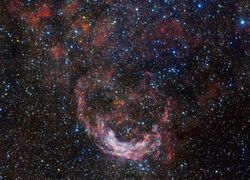Astronomy:NGC 3199
From HandWiki
Short description: H II region in the constellation Carina
| Emission nebula | |
|---|---|
 | |
| Observation data: J2000 epoch | |
| Right ascension | 10h 16m 32.8s[1] |
| Declination | −57° 56′ 02″[1] |
| Constellation | Carina |
| Designations | GUM 28, RCW 48[1] |
NGC 3199[2][1][3] is an emission nebula in the constellation Carina. It is commonly known as the Banana Nebula.[4] The object was discovered in 1826 by the Scottish astronomer James Dunlop.[5] It was thought to be the bow shock around the central star, WR 18, an especially hot and luminous Wolf–Rayet star; however, it was determined that the nebula formed due to the composition of local space, not because of the star's movement.[6]
See also
References
- ↑ 1.0 1.1 1.2 1.3 "NGC 3199". SIMBAD. Centre de données astronomiques de Strasbourg. http://simbad.u-strasbg.fr/simbad/sim-basic?Ident=NGC+3199.
- ↑ "Your NED Search Results". http://nedwww.ipac.caltech.edu/cgi-bin/nph-objsearch?objname=NGC+3199.
- ↑ "Revised NGC Data for NGC 3199". http://spider.seds.org/ngc/revngcic.cgi?NGC3199.
- ↑ Chadwick, Stephen; Cooper, Ian (11 December 2012). Imaging the Southern Sky. Springer. p. 75. ISBN 978-1461447498.
- ↑ Seligman, Courtney. "NGC Objects: NGC 3150 - 3199". http://cseligman.com/text/atlas/ngc31a.htm#3199.
- ↑ Toalá, J. A; Marston, A. P; Guerrero, M. A; Chu, Y.-H; Gruendl, R. A (2017). "Hot Gas in the Wolf–Rayet Nebula NGC 3199". The Astrophysical Journal 846 (1): 76. doi:10.3847/1538-4357/aa8554. Bibcode: 2017ApJ...846...76T.
External links
 |

